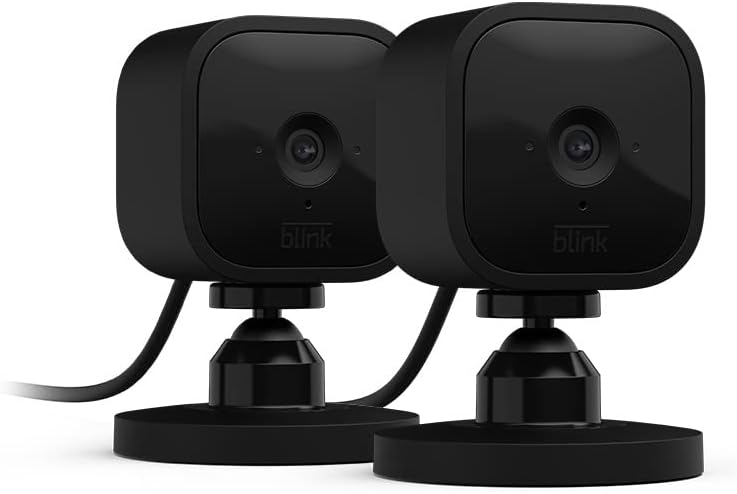Introduction to Video Doorbells
Video doorbells represent a significant innovation in home security technology, combining traditional functionality with advanced digital features. At their core, video doorbells are devices that integrate a camera, microphone, and speaker into a standard doorbell mechanism. This allows homeowners to see and communicate with visitors at their door, regardless of their physical location, through a smartphone or other smart devices.
The technology behind video doorbells typically includes high-definition cameras that capture video footage of the entrance area, often equipped with motion sensors that can alert homeowners to activity near the door. Additionally, two-way audio systems enable real-time conversations, enhancing security and convenience. Most models connect to home Wi-Fi networks, facilitating remote access and control through dedicated applications.
Historically, home security devices have evolved from basic locks and simple alarm systems to more sophisticated solutions. The advent of smart home technology has led to the increased adoption of interconnected devices aimed at enhancing residential security. Video doorbells fit into this broader category of home security systems by offering both deterrence to potential intruders and peace of mind to users. As a result, these devices have gained popularity among homeowners seeking to bolster their security measures.
As we delve deeper into the topic of video doorbells, it becomes evident that their rise in popularity is attributed not only to their practical capabilities but also their role in the modern landscape of smart home technology. The integration of video doorbells provides users with unprecedented control over their home security, which is a crucial aspect of contemporary safety measures.
Current Trends in Video Doorbell Adoption
The adoption of video doorbells has experienced significant growth in recent years, reflecting a broader trend toward smart home technologies. As of 2023, a remarkable percentage of households in the United States have adopted video doorbell systems, with estimates suggesting that around 30% of homes are equipped with such devices. This statistic highlights a clear shift in consumer preferences towards enhanced home security and convenience.
Demographic data reveals that the uptake of video doorbells is particularly pronounced among younger homeowners, especially those aged between 25 and 45. This age group tends to be more tech-savvy and is often drawn to the integration of smart devices within their homes. Furthermore, households with children are more likely to invest in video doorbells compared to those without, showcasing a particular emphasis on safety and surveillance.
Geographically, urban and suburban areas exhibit the highest levels of video doorbell adoption. Cities with higher crime rates often see an increase in security device usage, as residents seek peace of mind amidst concerns about safety. Notably, regions experiencing rapid population growth or development are also witnessing a surge in video doorbell sales, as new homeowners look to invest in modern security solutions.
Recent surveys indicate that the primary motivations for purchasing video doorbells include enhanced security, remote monitoring capabilities, and the ability to interact with visitors from anywhere. The introduction of features such as cloud storage and advanced motion detection has bolstered their appeal, making them not just a security measure but also a versatile home management tool.
Overall, the increasing penetration of video doorbells within households underscores a critical shift toward prioritizing home safety through innovative technology.
Reasons for Growing Popularity
The rise of video doorbells has been marked by a convergence of several key factors that align with today’s security needs and technological advancements. One of the foremost reasons for their popularity is the enhanced security they provide. Video doorbells allow homeowners to monitor their front porches in real-time, offering a live view of visitors and potential intruders. This capability not only helps in deterring criminal activities but also enables users to capture video evidence, which can be vital for law enforcement in case of an incident. Many users report a significant feeling of safety after installing these devices, as they act as both a physical and psychological barrier against threats.
Convenience is another crucial aspect driving the adoption of video doorbells. These devices facilitate two-way communication, allowing homeowners to interact with visitors from anywhere via their smartphones. This feature proves invaluable for individuals who may be away from home, ensuring they can manage deliveries and visitors without needing to be physically present. Users have shared anecdotes of how this immediate connectivity made it possible to receive packages securely or greet guests without unnecessary hassle.
Moreover, the integration of video doorbells with smart home technology plays a substantial role in their growing appeal. Many modern video doorbells sync seamlessly with other smart devices, such as security systems and home assistants, creating a comprehensive home automation experience. This interoperability not only enhances user experience but also simplifies home management for many. Expert opinions highlight that as more households gravitate towards smart technology, the preference for integrated solutions leads to increased demand for video doorbells, cementing their position in contemporary domestic life.
Security Features of Video Doorbells
Video doorbells have gained considerable attention due to their impressive security features that elevate home security systems. One of the most significant attributes is high-definition video quality, which enables homeowners to clearly identify visitors. With resolutions often reaching 1080p or higher, this feature ensures that every detail is captured, enhancing the ability to recognize faces, license plates, and even packages left at the door.
Another crucial feature of video doorbells is night vision capabilities. This functionality allows for clear visibility in low-light conditions, ensuring that homeowners can monitor their entrances even after dark. Many models utilize infrared technology, providing a monochromatic view that remains effective regardless of ambient light, thereby increasing security during nighttime hours.
Motion detection is a hallmark of video doorbell systems, as it alerts homeowners to any movement near their property. This feature can differentiate between humans, pets, and objects, reducing unnecessary alerts and ensuring that users are notified only of relevant activity. Many models also allow for customizable motion zones, enabling users to define specific areas of interest, thus refining the alert system further.
Two-way audio capabilities enhance interaction between the homeowner and visitors, allowing communication without opening the door. This feature fosters a sense of security, as users can directly address delivery personnel or unknown visitors, determining whether to engage further or alert authorities if suspicious activity is detected.
Furthermore, cloud storage for recorded footage plays a pivotal role in modern security systems. By automatically uploading video recordings to a secure online platform, homeowners can easily access, review, and store footage. This not only ensures that valuable evidence is preserved but also allows for remote monitoring from mobile devices, thus adding another layer of security and peace of mind for users.
Potential Vulnerabilities and Concerns
As the adoption of video doorbells grows, it is crucial to examine the potential vulnerabilities and concerns associated with these devices. While they offer numerous benefits, such as enhanced security and convenience, they are not without their risks. One major issue is the potential for hacking. Cybersecurity experts have raised alarm about the ease with which hackers can exploit weaknesses in smart home devices, including video doorbells. Through inadequate encryption, weak passwords, or unsecured wireless networks, unauthorized individuals may gain access to the camera feed, potentially compromising the homeowner’s privacy and safety.
Additionally, privacy concerns arise regarding how data is collected and used by manufacturers. Video doorbells typically record and store footage, which can be accessed later for review. However, users may not always be aware of the data policies in place, leading to uncertainty about who has access to their recordings. There are instances where companies have shared data with third parties without clear consent from users, raising alarms about the potential misuse of personal information. It is essential for consumers to read privacy policies carefully and understand how their data is managed.
Malfunctions represent another area of concern. Technical issues can render video doorbells ineffective when they are needed most. For example, connectivity problems may result in loss of footage or delayed alerts, undermining the very security these devices are designed to provide. In some cases, product recalls have occurred due to safety issues or device failures, which highlights the necessity for consumers to select brands with reputable track records. By being aware of these vulnerabilities and taking proactive measures, users can mitigate risks associated with video doorbells while enjoying the diverse benefits they offer.
What to Consider When Buying a Video Doorbell
As the popularity of video doorbells continues to grow, prospective buyers should consider several key factors to ensure they select the model that best fits their needs. Firstly, camera resolution plays a significant role in the quality of video capture. Higher resolution cameras, such as those offering 1080p or even 4K, provide clearer images, which is particularly helpful in identifying faces or license plates. Buyers should look for models that feature night vision capabilities to enhance visibility after dark.
Detection range is another crucial aspect to examine. Video doorbells with adjustable angles and wide field-of-view options are preferable, as they can capture more activity around the entrance area. This feature is important for ensuring that the device doesn’t miss any motion near the door. Additionally, some models offer customizable motion detection zones, allowing users to reduce false alarms from pets or passing pedestrians.
Compatibility with smart home devices also warrants attention. Many video doorbells integrate seamlessly with existing smart home ecosystems, such as Amazon Alexa or Google Assistant, enabling voice-controlled operation and streamlined user experience. Ensuring that a selected model works well with the user’s current devices will enhance convenience and functionality.
Cloud storage subscription plans should not be overlooked, as they can vary widely among different manufacturers. Some video doorbells offer free cloud storage for a limited time, while others require ongoing subscriptions for unlimited storage options. Buyers should assess how long they wish to retain recorded footage and the cost implications of these plans.
Finally, user-friendly apps are crucial for a pleasant experience. The app should allow for easy setup, access to live feeds, and quick notification management. Reading reviews and comparing popular models online can provide insight into how different video doorbells perform in real-world conditions, guiding potential buyers to make an informed decision.
Integration with Smart Home Systems
The integration of video doorbells with smart home systems has significantly influenced their popularity and appeal. These devices not only function as standalone security features but also seamlessly interact with a variety of smart home devices, creating a cohesive security ecosystem. For instance, when paired with smart locks, video doorbells can enhance entry security by allowing users to see and communicate with visitors before granting access. This real-time interaction facilitates a higher level of security and convenience.
Furthermore, video doorbells are often compatible with smart security cameras, allowing users to access a comprehensive view of their property. This integration enables homeowners to monitor entry points more effectively, providing alerts when movement is detected at the front door or any other monitored area. The ability to interact with both video doorbells and security cameras through a single centralized application streamlines the user experience and improves overall security management.
Home automation systems take these integrations a step further by incorporating video doorbells into overarching security protocols. For example, when a visitor rings the doorbell, a pre-set routine could trigger indoor and outdoor cameras to start recording automatically. Simultaneously, lights can activate to illuminate the entrance, deterring potential intruders. This type of automation enhances both the functionality and safety of the home.
Management of these devices through centralized applications enables homeowners to customize alerts and access live feeds from their video doorbells, smart locks, and cameras from anywhere. The interconnected nature of these smart home components not only improves home security but also simplifies everyday interactions, demonstrating the value of integrating video doorbells into an advanced smart home framework.
User Experiences and Testimonials
Video doorbells have become integral to modern home security, offering users a practical and effective way to monitor their front entrances. Many homeowners report feeling an increased sense of safety after installation, as these devices provide real-time visibility and audio communication with visitors. For instance, Mary, a resident of a suburban neighborhood, shared her experience of how her video doorbell helped deter potential package thieves. After receiving alerts of movement on her porch, she was able to respond immediately, which not only thwarted the theft but also resulted in a nearby neighbor expressing gratitude for aiding in the neighborhood’s security. This shows how video doorbells foster community awareness and safety.
Additionally, families benefit from the diverse functionalities of video doorbells. The ability to receive notifications on smartphones ensures that parents can keep an eye on their children as they play outside or monitor unexpected visitors while multitasking indoors. For example, John and Lisa, parents of two, found the device particularly useful for ensuring that their children were safe while playing in the front yard. They praised the ease of interacting with delivery personnel via the two-way audio feature, which allowed them to provide special delivery instructions without having to step outside.
While many testimonials highlight positive experiences, some users have cited challenges. Issues like connectivity problems or difficulty in installation are sometimes reported, resulting in frustrations. However, support resources from manufacturers have helped users navigate these hurdles effectively. Overall, the consensus among users is that video doorbells significantly enhance home security and convenience. By compiling user testimonials, it becomes evident that—despite minor challenges—video doorbells represent a proactive approach to safety, instilling confidence and peace of mind in homeowners.
Conclusion and Future of Video Doorbells
As we reflect on the rising popularity of video doorbells, several key factors come to light. These devices have transformed the way homeowners approach security by combining convenience, enhanced monitoring capabilities, and accessibility. The demand for smarter home security solutions is evident, driven by widespread concerns about safety and the need for real-time interaction. As the landscape of home security continues to evolve, video doorbells are poised to play a significant role.
Looking ahead, advancements in technology are anticipated to further enhance the functionality of video doorbells. Innovations such as artificial intelligence and improved motion detection algorithms may provide users with even more accurate alerts and notifications. Moreover, integration with broader smart home systems is expected to streamline usability, allowing homeowners to control multiple devices from a single interface. This synergy between devices will create a more cohesive and responsive home security experience.
Consumer demands are also shifting, with preferences leaning towards customization and privacy features. Users are increasingly interested in having control over their data and the ways in which their footage is utilized. As manufacturers respond to these needs, we may see the introduction of more advanced privacy modes and user-centric settings, allowing homeowners to tailor their experience according to their specific requirements.
Ultimately, the future of video doorbells appears bright and promising, as they continue to enhance home security while adapting to the evolving needs of consumers. It is crucial for homeowners to stay informed about new features and technological advancements in this dynamic market. As the world of smart security devices unfolds, video doorbells will likely remain at the forefront of ensuring our homes are both safe and secure.






















